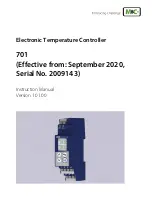
Installation & Operation Manual Merlin 1000V
Rev: 02 05-22
4
Installation
Typical Application & Location
Installation must be carried out by a licenced, insured contractor!
Ensure that detectors are not exposed to liquid or dust contamination!
Cables must be protected against mechanical damage!
Please refer to your detector manual for important information regarding coverage, location and positioning including
areas and conditions to avoid.
The Merlin 1000V gas pressure proving system designed specifically for use in educational buildings
and Laboratories with ventilation interlocking between the ventilation system and the gas solenoid valve.
The system is compatible with both current monitors and air pressure differential switches to interlock
with up to two fans.
This panel is to be used to carry out a gas proving test on the pipe work to highlight if there is a gas
appliance open or a gas leak in the laboratory. The Merlin 1000V is designed to give the teacher full
control over the incoming gas supply with the lockable main key-switch.
The Merlin 1000V can work in conjunction with carbon dioxide, natural gas, carbon monoxide and
LPG sensors. The Merlin 1000V
also has a built in “timeout” facility which will automatically shut off
the gas solenoid valve at the end of a specific time, this time can be adjusted to 2, 5, 8 hours or can be
overridden if required.
Mounting & Cabling
If mounting direct to wall - ensure the wall surface is flat to prevent base distortion!
Ensure the rear base is installed in the correct orientation as shown!
Where cable glands/conduits are used for wire entry, use 20mm (3/4 inch) max separated by at least 20mm!
Any parts that form part of the connections/installation must have a minimum fire-retardant rating of UL94v-2!
Damage to PCBs when creating cable entry points or attempting to remove the circuit board may void any warranty!
Restrain the hazardous live wiring from accidental loosening
to prevent wires from moving after installation and touching
parts of opposite polarity or at low voltages!
Isolate the equipment from all hazardous live power sources before opening the cover!
1.
Carefully remove the front cover from the unit by unscrewing the four bolts located at each corner. To
do this
–
use the socket wrench provided.
2.
Remove the keys and spare parts - keep safe.
3.
Mark the four screw holes located on the back of the enclosure to the wall. Ensure the wall surface is flat
to prevent base distortion. Drill out as necessary ensuring all swarf is removed from the box and holes
have smooth edges.
4.
After executing the mounting and the connections
–
replace the front cover and insert the security caps
over the four bolts.






























